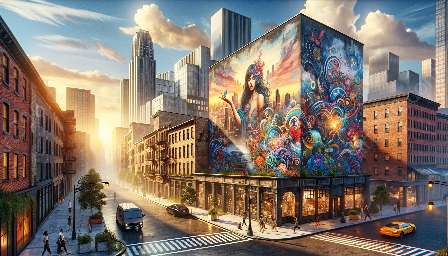Street art and graffiti have been prevalent forms of artistic expression in urban environments, often serving as a means for artists to convey their unique perspectives and engage with the public. Understanding the motivations and inspirations behind street art and graffiti involves delving into the historical, cultural, and social contexts that have shaped these art forms.
Street Art vs. Graffiti
Before exploring the motivations and inspirations, it's important to distinguish between street art and graffiti. While both are often created in public spaces, they differ in their underlying intentions and methods. Street art is typically characterized by its focus on aesthetics, storytelling, and often carries a message or political statement. On the other hand, graffiti is often associated with illicit markings, tags, and vandalism, reflecting a rebellious and often anonymous expression.
Motivations Behind Street Art and Graffiti
Several motivations drive artists to create street art and graffiti, including:
- Self-Expression: Street art and graffiti provide a platform for artists to express themselves freely, often without the constraints of traditional art spaces. This freedom allows them to communicate their identities and beliefs through their work.
- Social Commentary: Many street artists use their work to address social and political issues, aiming to spark conversations and provoke critical thinking among the public. They leverage public spaces as a canvas to convey powerful messages.
- Urban Revitalization: In some cases, street art is used as a tool for urban revitalization, transforming neglected or rundown areas into vibrant and culturally rich spaces. By bringing art to the streets, artists contribute to the beautification and regeneration of urban landscapes.
- Community Engagement: Street art and graffiti often invite community participation and interaction. Artists may involve local communities in the creation process, fostering a sense of ownership and pride among residents.
- Subcultural Expression: For many artists, street art and graffiti are linked to subcultures, such as hip-hop, skateboarding, and punk. They draw inspiration from these subcultures and use their art to communicate their allegiance and affiliation.
Inspirations Behind Street Art and Graffiti
The inspirations behind street art and graffiti are diverse and multifaceted, drawing from various sources, including:
- Urban Environment: The city itself often serves as a muse for street artists and graffiti writers. The architecture, textures, and energy of urban spaces provide abundant inspiration for their creations.
- Artistic Influences: Artists may draw inspiration from a wide range of artistic movements, styles, and artists, adapting and evolving these influences into their own distinct visual languages.
- Personal Experiences: Many artists derive inspiration from their personal experiences, memories, and emotions, infusing their work with a deeply personal and autobiographical touch.
- Social Issues: Social injustices, inequalities, and global challenges often inspire artists to create thought-provoking works that raise awareness and advocate for change.
- Cultural Heritage: Street art and graffiti frequently reflect and celebrate cultural heritage, folklore, and traditions, drawing from diverse cultural backgrounds and historical narratives.
Ultimately, the motivations and inspirations behind street art and graffiti are deeply rooted in the artists' desire to engage with their surroundings, communicate their voices, and contribute to the visual richness of urban environments.

